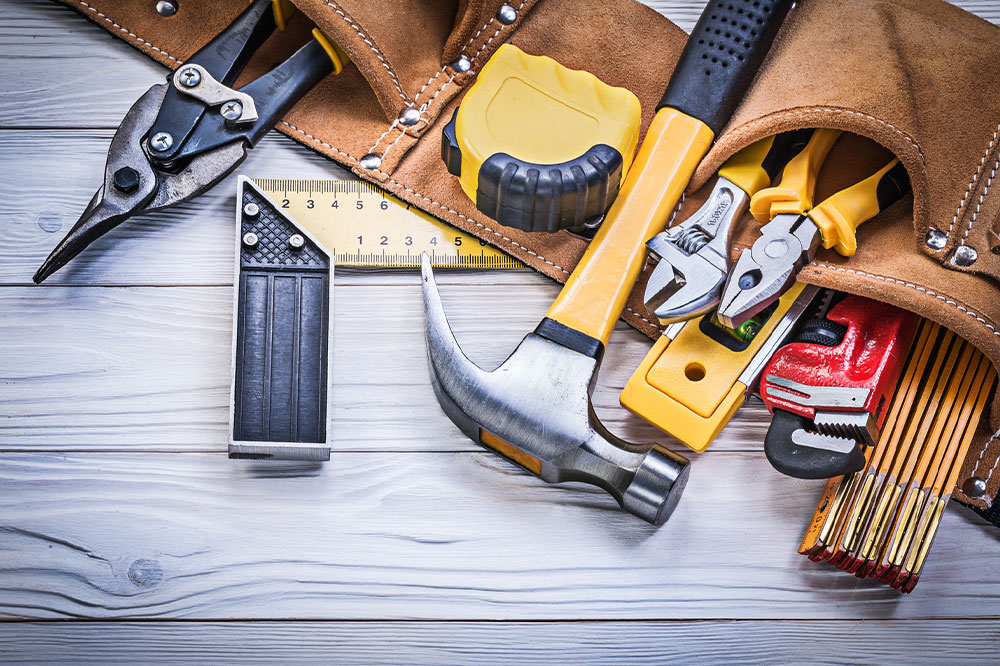
Commonly used tools for construction, repairs, and maintenance
Tools are commonly used for basic as well as advanced tasks like driving nails into the drywall to major renovation projects. DIYers or professionals, if you’re the kind to tinker around with carpentry, expand your collection and pick from multiple hand-operated and battery-powered tools to save time and effort. Here is a detailed guide explaining the types of tools that you can buy for projects, plus a few essential safety tips to pay attention to.
Hand tools
Hand tools don’t need any power to run and are mainly designed for select purposes in construction, repairs, and maintenance work. These tools are slow to operate and can become quite laborious to use. Without an external power source, your strength and precision in controlling the tool basically determines the quality of the task. Hand saws for cutting materials, hammers for driving in nails, fasteners to secure materials, and screwdrivers/wrenches used for locking materials are common hand tools used in daily construction work. You need practice with hand tools to increase your speed and improve efficiency for different jobs. All these tools can be bought as part of hand tool kits designed by various suppliers for compact storage and portability.
Power tools
Power tools require a motor and a battery source to run. So, these tools can exert more force and run faster, making them ideal for heavy-duty construction, repairs, and maintenance work. Power tools also offer better grip and precision for repetitive tasks to improve the quality of work. And you need proper training under guided supervision to handle power tools, as these components can be dangerous if not wielded properly. Examples of power tools are circular saws used for cutting materials, power drills used in place of hammers, and angle grinders or sanders used to polish the material.
Holding tools
Once the materials used in construction are cut and shaped for installation, you’ll also require holding tools like clamps and pliers to connect and combine different products. For example, clamps are used for furniture assembly when you need something to hold two parts together before they can be glued and assembled permanently. Pliers are used primarily for cutting and sharing electrical wiring to combine or create a new connection. Pliers can also easily cut different sizes of metal wire used for binding objects together.
Metal cutting tools
Metal is the most widely used construction material as its density and tensile strength provide the perfect foundation for building a new structure. Metal is also available in different shapes, sizes, and thicknesses based on construction, repair, or maintenance work type. So, you must use a combination of power and hand tools to shape, bend, smoothen, and weld metal together. Rasps, files, drills, and electric welders are commonly used metal cutting and reshaping tools.
Measuring tools
Hand tool kits also contain one of the most important construction items for proper measurement. It is almost impossible to build precisely without these simple tools and devices. From simple hand tools like measuring tapes to complex bubble balance leveling tools, all building operations depend on these tools for proper horizontal and vertical alignment. Even a few millimeters here or there can cause the structure to fail and risk compromising the entire unit. Some precision measuring tools are dial calipers for small distances, folding rules, metal rules, digital tape for large distances, and sonic and laser measures used to mark the correct length, distance, and angle. These tools are used interchangeably depending on the type of material.
Safety measures to note while using any tools
There are several smart toys available at your disposal for DIY projects. But you need to be careful when using them and ensure the following safety protocols:
Check the tool’s condition before use, especially if you plan to operate heavy-duty power drills, saws, and hammers.
Use safety gloves with inbuilt chainmail that prevent sharp saws and cuttings discs from ripping your fingers out clean.
Wear eye and face protection to prevent dirt and debris from affecting delicate organs.
Keep the workspace clean and operate heavy-duty hand tools with utmost focus.
Ensure the workspace is ventilated adequately so that you don’t inhale dust, debris, and fumes from cutting different materials.
Discard old tools and replace components promptly, as instructed in the service manual.
After unboxing it for the first time, always read the toolkit manual and learn about the various components.
Get tools service from time to time as they need regular maintenance for optimum functioning.
Pay attention to the task at hand and use smart tools to save time and effort.




